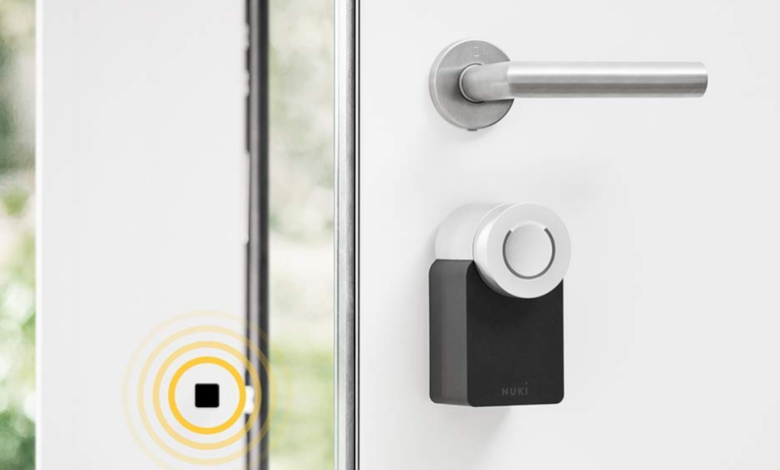The best smart locks for securing your home

Overview
This content originally appeared on Mashable for a US audience and has been adapted for the UK audience.
With the ever-growing selection of smart devices, you sometimes have to ask yourself: what will they think of next? In the case of the smart lock, it’s like a gadget from a science-fiction film — a self-unlocking door that you control from your smartphone.
Actually, smart locks have been around for a few years and they’re certainly nothing new to security-conscious homeowners. They give your home a level of protection that a regular lock and key just can’t. They also connect with other smart devices and systems. If you’re upgrading to a smart home, it’s a no brainer.
Before you part with your cash, it’s worth knowing a little more about what smart locks are and exactly what they can do. Here’s a quick guide on smart locks — and how to unlock the technology’s full potential for your home.
What is a smart lock?
In the simplest terms, it’s a device that you fit to your door or existing door lock that allows you to unlock the door without a key. You can control when the door unlocks — and who gets access — with a smartphone app. Smart locks can be attached to the interior of the door, acting as a kind of smart deadlock, while others are designed to entirely replace your door handle and lock mechanism.
What can smart locks do?
In addition to remote control via an app, you’ll find features that include geofencing, which unlocks the door when you come home, or virtual guest keys to let in specific people. Other features include timers for unlocking the door — which you can set to let in delivery drivers, for instance — or auto-locking when you leave the house.
How do you access a smart lock?
It depends on the smart lock, but there are a variety of ways. In some cases your smartphone may act as a key — the lock will open when the phone connects to it — while other locks use fobs, NFC cards, pass codes, or fingerprints. Some apps will allow you to add an extra level of security with biometric verification. The important thing is that you’ll never need to rely on a key or leave a key under the doormat ever again.
Do smart locks work with Alexa?
For the most part, yes, you can control your smart lock with Alexa and numerous other smart home voice assistants, such as Google Assistant. It’s especially useful if you have a smart home that’s already synced by one system and assistant.
Do you need a smart lock?
There are lots of reasons to fit your home or business with a smart lock, aside from the novelty factor of being able to open your place with your phone or fingerprint. (That in itself is a pretty convincing reason, though.) You can greatly improve the accessibility of your property, keep tabs on comings and goings, beef-up security, or simply add another device to your smart home set. There are other reasons, too. If you rent your property — through Airbnb, for instance — a pin code-enabled smart lock is a good way of giving renters temporary access to your home.
What is the best smart lock?
Owing to the popularity of smart home security systems, the market is loaded with high quality smart locks, promising all kinds of functionality. Picking the best device from this selection isn’t easy though, especially with so many brands and features to consider. To keep things simple, we’ve gone through all of the latest and greatest products, and put together a list of the best smart locks in the UK. The devices we have chosen offer up a selection of different functions, ranging from the simple to the not-so-simple. We think we’ve picked something to cover everyone.
These are the best smart locks for 2024.

The Yale Conexis L2 is a keyless smart lock that’s part of a wider smart security ecosystem that includes smart alarms, cameras, video doorbells, safes, and more. Security-wise, Yale has your home covered. Yes, the same Yale that makes regular house keys.
Installation of the Yale Conexis L2 is relatively easy. It’s made to fit as a replacement for most lift-to-lock door handles. All you need is the manual and a screwdriver. And once this device is installed, you get reliable keyless entry. It even sounds an alarm if someone attempts to gain unauthorised access.
Yale’s app is user-friendly and makes everything straightforward (it also works with Alexa and Google Assistant). It allows you to send virtual keys, including time-limited keys for those that are restricted to certain timeframes. You can also approve door access remotely or set up biometric verification.
The Good
The Bad
Details

The Nuki Smart Lock Pro is the fourth-generation upgrade of Europe’s most popular smart lock. Installation, like others on this list, is simple. You put a key into the door’s inside lock and fit the Nuki device over the top of it. From there, you control the lock with your smartphone, which doubles up as a key.
You can set up individual pass keys, set for select people and at specific times, while geofencing tech identifies when you’re coming home and unlocks the door as you approach. It also locks the door behind you automatically.
The Nuki supports Matter, which syncs different devices and ecosystems. This allows you to control the lock, along with other unrelated smart devices, via the same system, whether it’s Alexa, Google Assistant, or Apple.
It’s also worth noting that if you have a fiddly lock (we all have a lock that needs a bit of extra oomph, or requires a technique to open) it might not work.
The Good
The Bad
Details

The SwitchBot Wi-Fi Smart Lock is like a slightly cheaper version of the Nuki, but with one important addition that’s included in the initial cost: a keypad with fingerprint detection.
Just like the Nuki, you fit it over the key on the inside lock of your door. You then control with the app, with options to set lock timers, share access with other people, or unlock remotely.
With the keypad, however, you can unlock the door with a passcode, a SwitchBot NFC card, or your fingerprint. It can store fingerprints for all the family. You’ll never need a key ever again. Other features include auto-lock whenever the door closes, voice assistant connectivity, and an alarm if someone tries to force their way in. It’s on the uglier side — a bit of a lump hanging on your door — but whoever heard of an attractive door lock?
The Good
The Bad
Details

The Yale Keyless is another top choice from the brand. Which isn’t really surprising, given Yale’s place in the security market. The Keyless may look simple, but it’s (appropriately) much smarter than that. It comes with a touchscreen for PIN access, and if this doesn’t work for you, there are options for you to unlock it with the key card, key tag, fob, and phone app.
We think it’s perfect for Airbnb renters, as you can set temporary codes for visitors.
The lock itself is neatly designed and easy to install. It’s also built with a tamper alarm, bank level encryption, and incorrect pin code features. All these features combine to keep you safe. And we’d be remiss to not point out just how affordable this is. All other smart locks on this list are £200 minimum, but the Yale Keyless offers excellent features at half the price.
The Good
The Bad
Details

According to smart device brand August Home, it takes just ten minutes to install its August WiFi Smart Lock. It replaces the existing deadbolt on the interior side of the door. It works with your existing key, but gives you the option of key-free access.
Everything’s controlled by an easy-to-use app, with features that include remote unlocking, auto-lock, and virtual guest keys. You can set it to unlock just as you arrive home, for instance, so you don’t have to fiddle around finding keys, and it automatically secures the door once you’re inside.
You can set temporary access for anyone — friends, family, or even the Ocado driver. You can also control it via a selection of smart home assistants, including Alexa and Google Assistant, or set biometric access measures, via fingerprint or facial recognition features on your phone, for extra security.
The Good
The Bad
Details

Leah Stodart is a Philadelphia-based Senior Shopping Reporter at Mashable where she covers essential home tech like vacuums and TVs as well as sustainable swaps and travel. Her ever-growing experience in these categories comes in clutch when making recommendations on how to spend your money during shopping holidays like Black Friday, which Leah has been covering for Mashable since 2017.
Leah graduated from Penn State University in 2016 with dual degrees in Sociology and Media Studies. When she’s not writing about shopping (or shopping online for herself), she’s almost definitely watching a horror movie, “RuPaul’s Drag Race,” or “The Office.” You can follow her on X at @notleah or email her at [email protected].

Joseph Green is the Global Shopping Editor for Mashable. He covers VPNs, headphones, fitness gear, dating sites, streaming services, and shopping events like Black Friday and Prime Day.
Joseph is also Executive Editor of Mashable’s sister site, AskMen.

Matt Ford is a freelance contributor to Mashable.
This newsletter may contain advertising, deals, or affiliate links. Subscribing to a newsletter indicates your consent to our Terms of Use and Privacy Policy. You may unsubscribe from the newsletters at any time.



